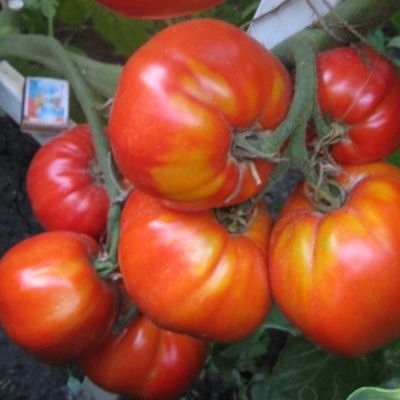
- Category: grade
- Growth type: indeterminate
- Appointment: fresh consumption, for juice, for ketchup and tomato paste
- Ripening period: mid-season
- Growing conditions: for open ground, for film greenhouses
- Bush size: tall
- Bush height, cm: up to 180
- Bush characteristic: powerful
- Foliage: medium
- Ripe fruit color: Red
The Apple Lipetsk variety is another worthy representative of tall tomatoes. Breeders have developed a vegetable crop with versatile fruits that are suitable for cooking, snacks and a healthy snack throughout the day.
Description of the variety
Usually the growth of bushes reaches 180 centimeters. Indeterminate specimens grow massive and powerful. Average leafiness.
Harvest purpose:
- juice;
- ketchup;
- tomato paste;
- salads and snacks.
Most summer residents prefer to eat vegetables fresh, without processing. The shoots of the bushes are covered with dark green leaves of a standard tomato shape. The shoots themselves are painted in the same color.
The main qualities of the fruit
Large red tomatoes gain weight from 150 to 300 grams, but if you take proper care of the beds, you can grow larger vegetables (weighing up to 450 grams). Small ribs are visible on the surface of the berries. Fully ripe tomatoes do not have a spot at the point of attachment of the fruit stem. The process of coloring the fruit is gradual. Their shape is round or oval. The pulp is fleshy and very juicy. A small number of chambers with seeds are formed inside.
Taste characteristics
The harmonious taste of ripe tomatoes combines sweetness and light sourness. Excellent taste characteristics are retained even after thermal processing.
Ripening and fruiting
The vegetative period is 110-115 days from the moment of germination to the first harvest. The Apple Lipetsk variety is considered mid-season.
Yield
The return of one bush is from 3 to 3.5 kilograms. This fruit crop is considered to be high-yielding.
The timing of planting seedlings and planting in the ground
In the first month of spring, seeds are sown for seedlings, and after a couple of months, when its age reaches 55-58 days, you can transplant it into the ground. In order for the seedlings to grow healthy, suitable conditions must be created for them. The seeds are deepened into containers filled with nutritious soil, sprinkled with warm and settled water. The containers are covered with a strong foil or glass. For germination, you need to keep the room temperature at about 25 degrees during the daytime and 18 degrees in the evening.
If the seeds germinated in a common container, you need to pick after the appearance of the second pair of full leaves. Before transferring seedlings to open ground or a greenhouse, they can be fed three times in 2 months.
Note: you need to buy ready-made soil or planting material only from trusted brands that guarantee high quality products. The seed fund presented on store shelves is treated with special compounds. Before purchasing, be sure to check the expiration date of the seeds.

Growing tomato seedlings is an extremely important process, because it largely depends on whether the gardener will be able to harvest at all. All aspects must be taken into account, from seedbed preparation to planting in the ground.
Landing scheme
It is impossible to thicken the planting, otherwise the yield will be significantly affected, and the plant's immune system will weaken. No more than three bushes are planted on one meter of land.

Growing and care
The site selected for transplantation is pre-cleaned, dug up and fed with complex nutrient compounds. Water the beds about once a week. In the heat, you have to irrigate more often, since the moisture evaporates quickly. You can not fill the bushes with water, so as not to provoke the development of fungus and other infections. For irrigation, it is advisable to use water that is settled and heated by the sun. The procedure cannot be carried out during active sun hours.
Various substances and preparations are used for fertilizers. At each stage of development, tomatoes need certain components. To gain a thick and lush plant mass, nitrogen is needed. Both ammonium nitrate and organic fertilizing are used (they must be dissolved in water before adding). During the flowering period, you need to use potassium-based formulations. To form a sufficient number of ovaries, preparations with potassium and phosphorus are needed. Without these components, it is impossible to achieve high yields and excellent taste of the fruit.
The roots of the plant need sufficient oxygen. To ensure full gas exchange, it is necessary to loosen the soil around the bushes several times a week and cover the soil around with a layer of organic mulch. Mulch performs several functions at once: nutrition, moisture preservation, protection of tomatoes from contact with soil, protection from pests. It also prevents weeds from growing.
Regular weeding is essential to prevent fungus and other bacterial infections from developing. With its help, they get rid of many garden pests.
Bushes of the Apple Lipetsk variety are formed into two stems. Removing unnecessary shoots is necessary so that the plant does not waste energy on the green mass. Tall plants are tied up as they develop. The supports used must be sufficiently strong and reliable. When installing the peg, they should not be deeply deepened into the ground, so as not to harm the root system.
To protect tomatoes from diseases and harmful insects, you can use ready-made chemical compositions or folk recipes, which also demonstrate high efficiency.




A plant needs different micronutrients at each stage of growth.All fertilizers can be divided into two groups: mineral and organic. Folk remedies are often used: iodine, yeast, bird droppings, eggshells.
It is important to observe the rate and period of feeding. This also applies to folk remedies and organic fertilizers.



























































































